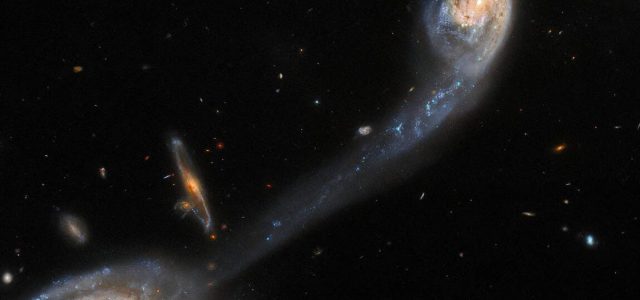


Between black holes devouring smallish stars and vacant space surrounding busy, bursting nebulas, caverns of darkness in our universe are often relieved by glimmers of light. Such poetic juxtaposition is starkly apparent in one of NASA’s latest Hubble Space Telescope images.
Last week, the agency released an ethereal view of galactic triplet Arp 248, also known as Wild’s Triplet for both the discoverer and the utterly extravagant nature of the spectacle itself. Behold.
Take a closer look at everything in this beautiful image of our electrifying universe.
ESA/Hubble & NASA, Dark Energy Survey/Department of Energy/Fermilab Cosmic Physics Center/Dark Energy Camera/Cerro Tololo Inter-American Observatory/NOIRLab/National Science Foundation/AURA Astronomy; J. Dalcanton
In this impeccable photo, two of three galaxies can be seen in the foreground of space’s void, bleeding into one another like they’re made of over-hydrated watercolor paint and forming what I can only describe as an intergalactic bridge. A third, unconnected realm stands in the far ground, enshrouded by deceptively tiny sparkles that represent a cosmic lifetime of even more galaxies scattered across the universe.
What’s especially mind-numbing about this image is that from Hubble’s vantage point — in Earth’s orbit, some 200 million light-years away — the three galaxies are compact enough to fit on our computer screens.
In reality, these worlds are many (many) light-years wide, holding an incomprehensible amount of doppelgangers to our sun, exoplanets like our solar system’s eight and moons akin to our glowing lunar companion.
They are miniature universes in themselves, existing on a scale simply unfathomable to the human mind yet available for us to download as desktop wallpapers.
It is, in fact, because of those hefty contents that the two massive spirals at the centerpiece of this image are linked by a luminous bridge in the first place. Both harness immensely strong gravitational forces and are therefore pulling on each other like they’re playing a gentle tug of war, accidentally creating what’s known as a tidal tail, or an elongated stream of stars and iridescent interstellar dust.
Tidal tails are usually the product of galaxies treading very close to one another while on a path toward merging into one huge galaxy. We’ve seen the breathtaking phenomena several times already — tidal tails are responsible for some adorable galaxy systems names, too.
“The Mice,” or NGC 4676, boasts merging galaxies about 300 million light-years away from Earth, and “The Tadpole,” or UGC 10214, contains a large galaxy in the process of shredding a smaller galaxy, another event type that resulted in an awesome tidal tail.
A Hubble Space Telescope image of NGC 4676, also known as “The Mice.”
NASA, H. Ford (JHU), G. Illingworth (UCSC/LO), M.Clampin (STScI), G. Hartig (STScI), the ACS Science Team and ESA
Even our Milky Way galaxy is currently on a collision course with Andromeda, meaning they may eventually generate some sort of intergalactic bridge too — but don’t worry.
The emptiness between stars and planets within galaxies is far greater than you might think.
When galaxies merge, it’s quite likely only a few actual collisions happen. Think about two large crowds entering a stadium, merging into one massive crowd. Most of the time, individuals wouldn’t literally bump into one another. They just settle near each other. Now imagine the same situation, except with about a light-year of space between every person.
Fasincatingly, the title “Arp” in Arp 248 comes from the surname of late astronomer Halton Arp who, along with astronomer Barry Madore, created the Atlas of Peculiar Galaxies in 1966.
“Each collection contains a menagerie of spectacularly peculiar galaxies, including interacting galaxies such as Arp 248, as well as one- or three-armed spiral galaxies, galaxies with shell-like structures, and a variety of other space oddities,” NASA said of the atlas.
It’s a vast work filled with yet more examples of our wonderfully contrasted universe, an expanse built from the mind of a poet and condensed with the skill of a machine.
